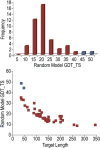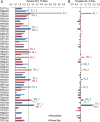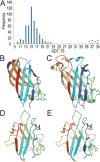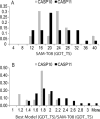Evaluation of free modeling targets in CASP11 and ROLL
- PMID: 26677002
- PMCID: PMC5576440
- DOI: 10.1002/prot.24973
Evaluation of free modeling targets in CASP11 and ROLL
Abstract
We present an assessment of 'template-free modeling' (FM) in CASP11and ROLL. Community-wide server performance suggested the use of automated scores similar to previous CASPs would provide a good system of evaluating performance, even in the absence of comprehensive manual assessment. The CASP11 FM category included several outstanding examples, including successful prediction by the Baker group of a 256-residue target (T0806-D1) that lacked sequence similarity to any existing template. The top server model prediction by Zhang's Quark, which was apparently selected and refined by several manual groups, encompassed the entire fold of target T0837-D1. Methods from the same two groups tended to dominate overall CASP11 FM and ROLL rankings. Comparison of top FM predictions with those from the previous CASP experiment revealed progress in the category, particularly reflected in high prediction accuracy for larger protein domains. FM prediction models for two cases were sufficient to provide functional insights that were otherwise not obtainable by traditional sequence analysis methods. Importantly, CASP11 abstracts revealed that alignment-based contact prediction methods brought about much of the CASP11 progress, producing both of the functionally relevant models as well as several of the other outstanding structure predictions. These methodological advances enabled de novo modeling of much larger domain structures than was previously possible and allowed prediction of functional sites. Proteins 2016; 84(Suppl 1):51-66. © 2015 Wiley Periodicals, Inc.
Keywords: CASP ROLL; CASP11; ab initio; alignment quality; domain structure; free modeling; protein fold prediction; protein structure; structure comparison.
© 2015 Wiley Periodicals, Inc.
Figures









Similar articles
-
Integration of QUARK and I-TASSER for Ab Initio Protein Structure Prediction in CASP11.Proteins. 2016 Sep;84 Suppl 1(Suppl 1):76-86. doi: 10.1002/prot.24930. Epub 2015 Sep 23. Proteins. 2016. PMID: 26370505 Free PMC article.
-
CASP 11 target classification.Proteins. 2016 Sep;84 Suppl 1(Suppl 1):20-33. doi: 10.1002/prot.24982. Epub 2016 Jan 27. Proteins. 2016. PMID: 26756794 Free PMC article.
-
Assessment of template-based modeling of protein structure in CASP11.Proteins. 2016 Sep;84 Suppl 1(Suppl 1):200-20. doi: 10.1002/prot.25049. Epub 2016 Jun 15. Proteins. 2016. PMID: 27081927 Free PMC article.
-
Some of the most interesting CASP11 targets through the eyes of their authors.Proteins. 2016 Sep;84 Suppl 1(Suppl Suppl 1):34-50. doi: 10.1002/prot.24942. Epub 2015 Nov 16. Proteins. 2016. PMID: 26473983 Free PMC article.
-
A decade of CASP: progress, bottlenecks and prognosis in protein structure prediction.Curr Opin Struct Biol. 2005 Jun;15(3):285-9. doi: 10.1016/j.sbi.2005.05.011. Curr Opin Struct Biol. 2005. PMID: 15939584 Review.
Cited by
-
Why Is There a Glass Ceiling for Threading Based Protein Structure Prediction Methods?J Phys Chem B. 2017 Apr 20;121(15):3546-3554. doi: 10.1021/acs.jpcb.6b09517. Epub 2016 Oct 26. J Phys Chem B. 2017. PMID: 27748116 Free PMC article.
-
UniCon3D: de novo protein structure prediction using united-residue conformational search via stepwise, probabilistic sampling.Bioinformatics. 2016 Sep 15;32(18):2791-9. doi: 10.1093/bioinformatics/btw316. Epub 2016 Jun 3. Bioinformatics. 2016. PMID: 27259540 Free PMC article.
-
Critical assessment of methods of protein structure prediction: Progress and new directions in round XI.Proteins. 2016 Sep;84 Suppl 1(Suppl 1):4-14. doi: 10.1002/prot.25064. Epub 2016 Jun 1. Proteins. 2016. PMID: 27171127 Free PMC article.
-
De novo protein structure prediction using ultra-fast molecular dynamics simulation.PLoS One. 2018 Nov 20;13(11):e0205819. doi: 10.1371/journal.pone.0205819. eCollection 2018. PLoS One. 2018. PMID: 30458007 Free PMC article.
-
Improving fragment-based ab initio protein structure assembly using low-accuracy contact-map predictions.Nat Commun. 2021 Aug 18;12(1):5011. doi: 10.1038/s41467-021-25316-w. Nat Commun. 2021. PMID: 34408149 Free PMC article.
References
-
- Lee J, Lee J, Sasaki TN, Sasai M, Seok C, Lee J. De novo protein structure prediction by dynamic fragment assembly and conformational space annealing. Proteins. 2011;79:2403–2417. - PubMed
-
- Rohl CA, Strauss CE, Misura KM, Baker D. Protein structure prediction using Rosetta. Methods Enzymol. 2004;383:66–93. - PubMed
-
- Simons KT, Kooperberg C, Huang E, Baker D. Assembly of protein tertiary structures from fragments with similar local sequences using simulated annealing and Bayesian scoring functions. J Mol Biol. 1997;268:209–225. - PubMed
Publication types
MeSH terms
Substances
Grants and funding
LinkOut - more resources
Full Text Sources
Other Literature Sources

